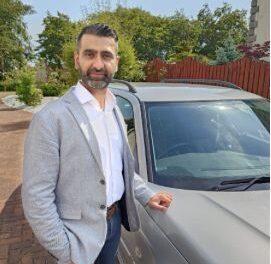Downside Primary School in Bedfordshire has installed a service-free solar powered ventilation system utilising carbon dioxide (CO²) and temperature controllers enabled by batteryless radio technology from EnOcean.
As part of the UK government’s Building Schools for the Future (BSF) investment programme, Downside Primary School in Luton has been granted a low energy, natural ventilation system to reduce the building’s energy consumption and provide a continuous fresh air supply throughout all the classrooms, assembly hall and gymnasium.
Since installing this natural ventilation system, Downside Primary School has ensured compliance with building regulations (relating to the provision of adequate means of ventilation in schools and education establishments), and has also benefited from various economic, environmental and safety advantages.
By using EnOcean wireless, batteryless controls in association with this system, the need for installation cabling was eliminated altogether. As a result, there was no occupant disruption, or inconvenient noise or mess caused from having to chase walls and drill holes for cabling. For this reason, and the fact that no repair or redecoration was needed after installation, the school could reap the benefits of the energy saving ventilation system during the school year rather than having to wait until the end of term.
Natural vs mechanical
In addition to ease of installation, the main purchasing criteria when it came to selecting a suitable natural ventilation system were user friendly design, value for money, energy saving potential and overall performance.
A natural ventilation system controlled by energy harvesting sensors and switches presented various advantages over alternative options, such as mechanical ventilation or air conditioning, for its ability to lower energy consumption, operating and maintenance costs. The fundamental difference between mechanical and natural ventilation is that the latter is driven by wind and/or temperature differences between the inside and outside of a building. This makes it a more environmentally responsible alternative as no fossil fuels are necessary. Furthermore, as the system’s enabling wireless control technology operates entirely without batteries this reduces future maintenance or service call-out requirements.
Within a building, the recommended guideline for ventilation is eight litres of fresh air per person per second, which provides a careful balance between the human health benefits of increased ventilation and energy usage. Controlled natural ventilation simplifies the monitoring of ventilation energy consumption as it only ever vents the necessary amount of fresh air when carbon dioxide reaches a certain level.
Downside Primary is a single storey building which lends itself well to natural ventilation. A seasonal controlled ventilation method avoids cold draughts and wasted heat, as well as security concerns associated with having to open windows at ground level. Furthermore, natural air flow is proven to increase concentration levels, due to the healthy supply of oxygen continually replacing stale air, and eliminates ‘sick building syndrome’.
24 hour ventilation
A specific requirement of Downside Primary was to allow 24 hour ventilation. The school required a system that would refresh the classrooms with cooler air over night. They also wanted increased evening ventilation rates in the assembly hall where after school concerts, drama plays and sports events are often held – a capability that traditional ventilation solutions weren’t able to provide.
With the help of Wates Construction, hired as the main contractors to manage the overall project, the Intelivent Solarstore System from GDL Air Systems was identified as the ideal solution to serve the school’s needs.
Intelivent Solarstore allows 24 hour ventilation by way of night purging. It includes a DC battery but because the solar cell is also bigger than average it can run for up to 17 hours without a battery. This offers increased flexibility and was a major reason why the system was chosen.
Self powered wireless technology
A central feature of the Intelivent Solarstore is its self powered wireless controls. The integrated Distech Controls smart actuator is enabled by EnOcean self powered wireless sensor modules, which operate entirely service-free without batteries. Instead they harvest their energy from their surrounding environment – from slight changes in motion, pressure, light or temperature, for example.
Devices that operate using the EnOcean standard with Distech’s smart controllers are a temperature sensor (powered by solar cells), wireless switch (powered by a radio signal transmitted when the rocker switch is pressed) and wireless PIR (powered by light). The latter can be integrated into the application to control the temperature and CO² levels under actual occupancy. This can also be integrated into an existing BMS network to signal room occupied for occupancy control set point.
Additional features of the Intelivent Solarstore system are a photovoltaic solar cell, a DC carbon fibre battery and DC dual reversible fans. The system has a unique design that eradicates the ‘cold drop’ effect and allows the unit to work as a front line heating system. Natural fresh air enters the building through custom-built wall mounted units and passes through the classrooms via a series of grilles and dampers. The stale, warm air leaves the building via several roof turrets. Modulating dampers give added control to the ventilation rate and the front attenuator baffle gives additional noise reduction to the unit.
The air flow volume provided through the roof turrets is driven by the external wind speed and the volume is controlled by both the internal air temperature and CO² levels. The intelligent, EnOcean enabled wireless controls and sensing devices determine the modulation and control of the dampers for the requirement of the given area.
Logical wireless control
A single Distech wireless control system, or smart actuator, can manage up to six Intelivent Solarstore units and can work wirelessly via CO² emissions, temperature sensors or simple on/off switches. Compared to a traditional wired BMS system, the smart actuator is simple to operate, reliable, cost-effective and provides more flexibility than traditional controllers. It also has a longer life expectancy and features an integrated wireless receiver that can be used with a variety of wireless sensors and devices.
Downside Primary teachers can now control the temperature of the classrooms via a user-friendly configuration interface without training and the system also allows manual override.
The 24 hour solar-powered ventilation system is the only one of its kind to date, with EnOcean wireless, batteryless sensors at its heart. As an eco-friendly product it delivers significant energy savings to educational establishments like Downside Primary School by lowering carbon emissions and reducing operating and maintenance costs in a naturally controlled, flexible environment.




